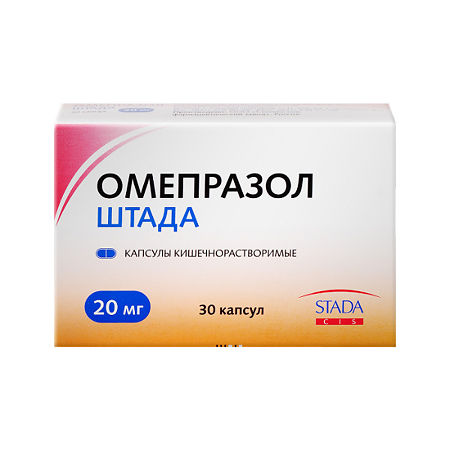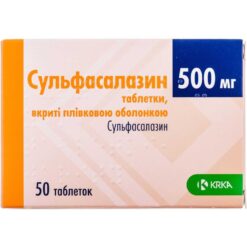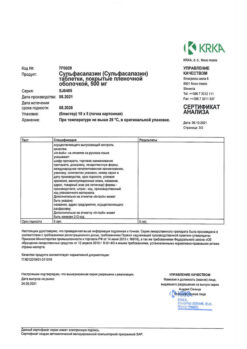No products in the cart.
Omeprazole Stada, 20 mg capsules, 30 pcs.
€1.00
Out of stock
(E-mail when Stock is available)
EAN: 4610012020338
SKU: 231236
Categories: Medicine, Stomach, intestines, liver, Ulcer and gastritis
Description
Omeprazole is a benzimidazole derivative, a specific proton pump inhibitor (enzyme H+/K+-ATPase), has a highly selective mechanism of inhibition of hydrochloric acid secretion in the stomach.
It is a weak base.
Concentrated and converted to the active form in a very acid environment of secretory tubules of parietal cells, where it inhibits the proton pump, thus blocking the final stage of hydrochloric acid synthesis.
The effect is dose-dependent and provides effective suppression of basal and stimulated hydrochloric acid secretion, regardless of the nature of the stimulating factor.
Effect on hydrochloric acid secretion
The antisecretory effect of omeprazole comes within the first hour after oral intake and lasts for 24 hours, the maximum effect is reached after 2 hours.
Once daily intake provides rapid and effective inhibition of daytime and nighttime secretion of hydrochloric acid. The maximum effect is reached within 4 days of treatment.
After withdrawal of omeprazole secretory activity of exocrine glands of the stomach is fully restored in 3-5 days.
In patients with duodenal ulcer omeprazole 20 mg causes stable decrease of intragastric acidity by at least 80% (according to 24-hour pH-metry).
At the same time a decrease of the average maximum concentration of hydrochloric acid after pentagastrin stimulation by 70% is achieved.
When administered daily, it maintains intragastric pH value ≥3 on average for 17 hours a day.
In patients with gastroesophageal reflux disease (GERD), omeprazole reduces the effects of hydrochloric acid on the esophagus.
No tachyphylaxis is observed during treatment with omeprazole. After discontinuation of therapy secretory activity is fully restored in 3-4 days, there is no “ricochet” syndrome.
Effect on Helicobacter pylori
Omeprazole has in vitro bactericidal effect against Helicobacter pylori.
Eradication of Helicobacter pylori when using omeprazole together with antibacterial agents is accompanied by rapid elimination of symptoms, a high degree of healing of mucosal defects
gastric and duodenal defects and prolonged remission of peptic ulcer disease, reduces the probability of complications (gastrointestinal bleeding) and eliminates the need for continuous supportive therapy.
Other effects associated with inhibition of hydrochloric acid secretion
Due to reduction of hydrochloric acid secretion in blood plasma concentration of chromogranin A increases (may be of importance during examination of patients for detection of neuroendocrine tumors) (see also section “Indications.
Pharmacokinetics
Absorption.
Omeprazole is rapidly absorbed from the gastrointestinal tract; maximum plasma concentration is reached on average within 2 hours. It is absorbed in the small intestine within 3-6 hours.
Bioavailability after a single intake is about 40%, after 3-5 days of intake once a day it increases to 60%. Food intake does not affect the bioavailability of omeprazole.
There is a correlation between inhibition of hydrochloric acid secretion and the area under the curve “concentration-time” (AUC) of omeprazole.
Distribution.
Binding to plasma proteins is about 95%. The volume of distribution is 0.34 l/kg.
Metabolism.
Omeprazole is completely metabolized in the liver with the participation of CYP2C19 (mainly) and CYP3A4 isoenzymes to form 6 pharmacologically inactive metabolites; the main metabolite is hydroxyomeprazole.
Taking into account high affinity of omeprazole to CYP2C19 isoenzyme, competitive interaction with other drugs, metabolism of which involves this isoenzyme, is possible.
In addition, variability of antisecretory effect is possible depending on CYP2C19 gene polymorphism. It is excreted as metabolites by kidneys (up to 80%) and with bile through intestine (20-30%). Half-life period is 0.5-1.5 hours.
Special groups of patients
Elderly patients. In patients over 65 years old a slight decrease of omeprazole metabolism is noted.
Patients with impaired renal function.
In chronic renal insufficiency, excretion of omeprazole decreases in proportion to decreased creatinine clearance.
Patients with impaired liver function.
In patients with chronic liver disease with impaired liver function the metabolism of omeprazole is decreased, bioavailability increases to 100%, clearance decreases to 70 ml/min and the half-life lengthens to 3 hours.
No tendency to cumulation of omeprazole was found when administered once daily.
Children.
When used in recommended doses in children over 1 year of age, plasma concentrations of omeprazole are similar to those in adults.
Indications
Indications
Active ingredient
Active ingredient
Composition
Composition
How to take, the dosage
How to take, the dosage
Interaction
Interaction
Special Instructions
Special Instructions
Contraindications
Contraindications
Side effects
Side effects
Overdose
Overdose
Similarities
Similarities
Additional information
| Shelf life | 3 years. |
|---|---|
| Conditions of storage | In a dry, light-protected place at a temperature no higher than 25 ° C. Keep out of reach of children. |
| Manufacturer | Chemopharm LLC, Russia |
| Medication form | capsules |
| Brand | Chemopharm LLC |
Related products
Buy Omeprazole Stada, 20 mg capsules, 30 pcs. with delivery to USA, UK, Europe and over 120 other countries.









